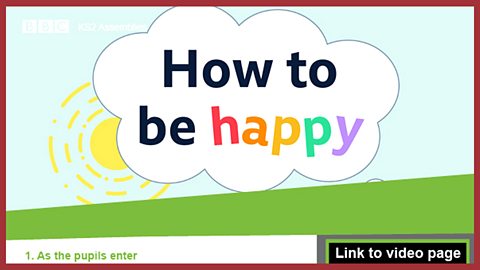In short...
Themes: How to be happy; mindfulness; child mental health; dealing with worries.
Summary: This assembly is suitable for any time of year, but you may choose to link it to a particular event such as Mental Health Awareness Week or World Mental Health Awareness Day (10 October 2023). The assembly features a film in which KS2 pupils discuss their emotions and what mindfulness means to them. It ends with a short mindfulness exercise which you can pick up on in the assembly.
Resources: the and an for you to display and use as you wish.

The video
The video begins with a KS2 pupil explaining what emotions are and giving examples of some emotions we typically feel. He compares emotions to the weather, changing from happy to sad in the same way that the weather changes from rainy to sunny. He then advises everyone to remember that sad feelings will pass and that they will feel happy again.
He introduces the idea of mindfulness and ends by leading the audience in a short mindfulness exercise and invites everyone to practise doing it as a means of keeping calm.
Video questions
Questions answered by pupils during the video:
- What is mindfulness?
- How does mindfulness help with emotions?
- What do you do if you want to feel happier or less worried?
- Is it important to be happy?

Key links
Download / print the assembly framework ready for use

Click to display the image full-size


Suggested framework
1. Entry music
'Don't worry be happy' by Bobby McFerrin. There are various versions available on YouTube.
2. Introduction
You could start by asking pupils to name some of the emotions they have felt this week. Then ask them to think of something they do to help themselves if they are feeling sad or worried. Share some answers from pupils. Explain that they are going to watch a short video in which some other schoolchildren will give them some tips for ways to deal with their emotions.
3. The video
Play the video. The duration is 3' 46" and the last words are: '…the more you practise doing this, the easier you will find it to calm down when you need to.'
4. After the video
Ask the pupils to spend a few moments reflecting on what they heard. Did they get any good ideas for ways they could manage their emotions? You could lead the pupils in another short mindfulness exercise, asking them to focus on their breathing, just like the boy in the film suggested.
5. Time to talk
Invite a few pupils to share how they felt during the mindfulness exercise. Then ask:
- Is it important to be happy?
- Is it possible to be happy all the time?
- Can you think of something you can do this week to help if you are feeling sad or anxious?
6. Opportunity to sing
'I'm feeling happy' from Out of the Ark. Suggestions from ≥…»ÀøÏ ÷ collections below.
7. Opportunity to reflect
Close your eyes and think of a place that makes you feel happy…
It might be a place at home…perhaps the garden…
Or it might be a place you've been to on holiday…
It might be a place you've never actually been to, but you can picture it and you can imagine feeling really happy there…
Picture yourself there now as you breath deeply…focusing on your breath going in and out…in and out…
Suggest that pupils think of this happy place and practise the deep breathing next time they are feeling anxious or worried.
8. Opportunity for prayer
Use your usual form of address ('Dear God', 'Lord Jesus', etc) and:
Thank you for giving us lots of reasons to be happy.
Thank you for always being by our side when we are sad.
We pray that you help us to remember you when we feel sad and worried.
Amen.

Suggested songs
Song: 'Peace is flowing' (Come and Praise, no 144. Vocal version)
Peace is flowing like a river,
Flowing out through you and me,
Spreading out into the desert,
Setting all the people free.Love is flowing like a river,
Flowing out through you and me,
Spreading out into the desert,
Setting all the people free.Joy is flowing like a river,
Flowing out through you and me,
Spreading out into the desert,
Setting all the people free.Hope is flowing like a river,
Flowing out through you and me,
Spreading out into the desert,
Setting all the people free.

